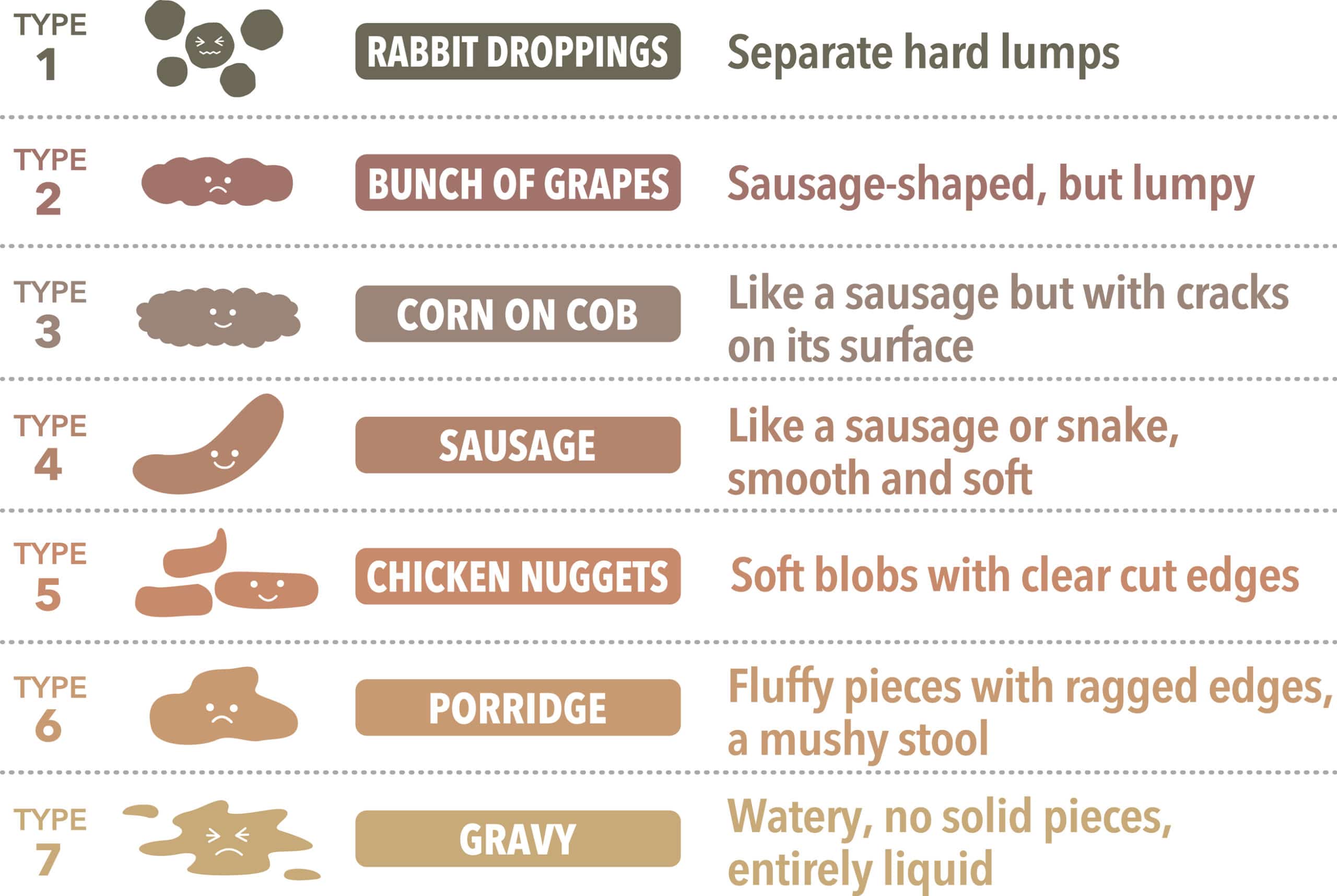What does my poop mean?
What Does My Poop Mean?
(What The Color and Consistency of Your Poop Says About Your Health!)
Click Here For Transcript of "What Does My Poop Mean" Video
Poo quiz time!!!!
What does your poo say about you?
Is your poop consistent or runny or hard as a brick?
And what’s the best?
Poo Doctor here to get to the bottom of it. Ha!
So when it comes to consistency, quickly quiz yourself with the Bristol Stool Chart and rate your poop.
You may think I’m a 10, but your best poop is a 3 or a 4… looking like me… not too hard, not too soft, just right!
Poop like me! Poop that makes you proud Ha! I did it again.
For the full chart and more info, just click below. Until then, Like this video and post for good poop. Subscribe for great poop!
Have you ever considered that your daily bathroom visits are a direct line to understanding your health? It’s true; the story your stool tells is a unique glimpse into your overall well-being and digestive health. Each aspect, from the frequency and texture to the color and smell, provides valuable clues about how your body is functioning internally.
Exploring the significance of your bowel movements is not just about curiosity; it’s about becoming proactive about your health. Recognizing variations can help catch potential issues early or confirm that your dietary habits are on the right track. This guide will provide insights into what your stool’s characteristics might indicate about your health without venturing into complex medical jargon.
If this topic sounds like it could keep you and your peers intrigued and informed, consider sharing it. Everyone has this in common, yet it’s rarely discussed openly. It’s time to break the taboo and bring some light to what goes on in the privacy of the bathroom. Spread the word, and let’s start the conversation on a topic that affects us all every day!
Decoding the Frequency of Your Bowel Movements
The frequency of bowel movements varies significantly among individuals, and understanding this aspect of digestive health can provide insights into personal wellness. Typically, a healthy range can be anywhere from three times a day to three times a week. Falling consistently within or outside this range might indicate specific health conditions or dietary patterns.
If you find yourself visiting the bathroom more than three times a day, it could suggest that your digestive system is processing food too quickly, possibly not absorbing all the nutrients effectively. This might be due to a high intake of certain types of food, stress, or a more complex condition like Irritable Bowel Syndrome (IBS).
Conversely, fewer than three bowel movements a week can often indicate inadequate fiber or fluid intake. Still, it may also suggest an underlying issue, such as hypothyroidism or a sedentary lifestyle.
Monitoring the regularity and changes in your bowel movement patterns is a simple way to stay attuned to your body’s health. If you notice persistent changes, consulting with a healthcare professional may be wise. Understanding and adjusting to what your body is telling you through these patterns can significantly enhance your digestive health and overall well-being.
What does my poop mean and what does my poo say about me? Is your poop consistent or runny or hard as a brick? And what’s the best? Poo Doctor is here to get to the bottom of it.
Understanding Your Digestive Health: The Bristol Stool Chart
The Bristol Stool Scale is a medical tool used to classify types of feces into seven categories. This chart is invaluable for identifying and understanding various types of stool and what they may indicate about your digestive health.
If you notice a persistent pattern in the lower types (1-2) or higher types (6-7), consulting a healthcare professional to discuss potential dietary adjustments or medical interventions may be beneficial.
This chart not only helps understand bowel health but also aids in discussing sensitive topics with medical professionals more objectively.
Deciphering the Color Code: What the Color of Your Poop Means
The color of your stool is a powerful indicator of your digestive health, providing clues about your diet and potential medical conditions. Variations in stool color might be nothing to worry about; diet or medications often influence them. However, certain colors can signal health issues that may require medical attention.
Here’s what different stool colors generally indicate about your health:
1. Brown
Brown is the standard color for stool and is a sign of a healthy digestive system. The color comes from bile produced in the liver, which is necessary for digesting fats.
If your stool is consistently brown, it usually means your diet is balanced and your intestines and liver work as they should.
2. Green
Green poop can be caused by eating large amounts of green, leafy vegetables or foods that contain green coloring.
It can also occur when the stool moves too quickly through the intestines (such as with diarrhea), preventing bile from breaking down completely.
3. Yellow
Yellow poop can be a sign of excess fat in the stool, such as when there is a malabsorption disorder like celiac disease. If the stool is also greasy and foul-smelling, it suggests difficulty absorbing fats properly.
Consulting a healthcare provider is advisable to rule out gallbladder issues or pancreatic disorders.
4. Black
Black stool can indicate bleeding in the upper gastrointestinal tract, such as from a stomach ulcer. Iron supplements or certain medications can also cause it. If the black stool is not linked to diet or medication, seeking medical evaluation to exclude potential bleeding issues is essential.
5. Red
Red poop can be alarming and is often due to bleeding in the lower digestive tract, such as from hemorrhoids or colorectal cancer. However, eating beets, cranberries, or tomato-based products can also color the stool red.
If the red color cannot be linked to diet, consulting a healthcare professional is crucial.
6. White or Clay-Colored
Pale poop that is white, clay-colored, or light gray can indicate a lack of bile, which may suggest a blockage of the bile ducts or problems with the liver, gallbladder, or pancreas. This color change can also occur with certain medications.
Consulting with a healthcare provider is recommended to address potential underlying conditions.
Monitoring the color of your stool provides valuable insights into your health and can help you identify changes that may need further investigation.
Regular observation and understanding of these signs ensure proactive management of your digestive health.
If you notice persistent changes in stool color, especially those that cannot be explained by changes in diet or medications, seeking medical advice is essential.
What is your poop telling you?
Importantly, when it comes to consistency, quickly quiz yourself with the Bristol Stool Chart and rate your poop. The color of your poop depends on a few factors: A) Diet and B) How much bile is in it.
A quick definition for you: Bile is a yellow-green fluid that helps digest fats. A healthy-looking poop, then, should reflect a mixture of all the colors of the food you consume and bile. Any form of brown color, or even green shades, is considered to be fine.
Types of poop one encounters is categorized by the Bristol Stool Chart. This chart is a generalized indicator of how or why different types of poops look and feel a certain way. The 7 types of poop are broken up into categories based on a 2,000-person study!

Does your poo look this good? If you have Bristol Type 3 or 4 – your poop is considered “normal”! Bristol Type 1 or 2, is where the poop is hard and difficult to pass, are indicative of constipation. Often, these types of stool can be painful to pass – but don’t worry – Doctor Poo has a recommended healthy-gut switch solution…just keep reading!
Should you ever worry about your poop?
Always consult your healthcare provider if you have any concerns about what your poop means. People are asked to call their healthcare providers if: They experience severe levels of abdominal pain or discomfort with diarrhea that does not go away when they poop or fart. Also, if diarrhea is accompanied by a fever of 101 degrees Fahrenheit or higher, chills, vomiting, or fainting, call your physician immediately.
What is unhealthy poop?
An unhealthy poop is when one poops too often (hence, your doctor asking you if you poop more than three times daily) or not pooping often enough (As such, less than three times a week) and also excessive straining when pooping. Poop that is colored red, black, green, yellow, or white. greasy or fatty stools are unhealthy.
Help fix so many of your digestive and bathroom issues, such as gas and bloating, and improve your overall health with this patented molecule that is backed by Ivy League doctors by clicking here!
Doctor Poo Provides More Valuable Answers for Those Hard-to-Ask Questions Below:












